Sword and Fairy 7 is the cutting-edge PC exclusive nobody's talking about
A deep story, high-end visuals, ray tracing - this is an impressive game.
The era of the high-end PC exclusive may well be a thing of the past, but every once in a while a game comes along that is rather special, that can't be played anywhere else and in the case of Sword and Fairy 7, by Softstar Technology in Beijing, we have an excellent role-playing game that piles on the high-end visual features, including ray tracing support - all courtesy of Unreal Engine 4. It's a quality game and looking into it, I've unwittingly stumbled upon a sleeping giant of a games franchise. Sword and Fairy has spawned many games and live action adaptations, and this latest series entry is a high quality production that, curiously, has received very little editorial coverage. That changes today!
The story begins in 1995 when The Legend of Sword and Fairy was first released for MS-DOS, telling the tale of a luckless orphan in provincial China who sets off on an adventure to save his ailing aunt. Hailed as a pioneering game for Chinese development, its tragic story, mazes and turn-based battles struck gold, selling many millions of copies. So why didn't it receive the same kind of profile as, say, Ultima or Final Fantasy? The reasons are legion, but importantly, The Legend of Sword and Fairy was never officially released with an English translation - and I've only managed to sample it via a translation patch released many years later.
Thankfully, Sword and Fairy 7 comes with English text out of the box, but even so, barriers of entry are still there to a degree: the game's menus and interface are translated - yet all the audio and signage in the game is in Chinese. Personally, I love subtitles and prefer local audio to often inaccurate dubbing, but for a release with so many cutscenes and NPC interactions, I can understand how the sheer volume of reading may be too much for many. Still, there's much to commend this RPG. Far removed now from its origins, combat is all in real-time now with differing move sets and special attacks - and the ability to change characters on the fly to others in your party who specialise at different techniques.
It's all very familiar if you have played a modern Final Fantasy game, though some elements - such as splitting up the world and traversing between areas with your fairy mount - are a little old-school, but at least it cuts out any open world bloat. This is actually a great benefit to the game's visuals: dividing the world into smaller spaces has allowed the developers to invest in the diversity of the visuals on show, which are seriously impressive. You have a quintessential rural Chinese village, Taoist inspired temples and more fantastical environments such as frozen forests and a palace in the skies. There are likely more - I've only played about eight hours' worth so far.
One of the game's greatest strengths is character modelling, exciting style, vibrancy and detail, not saying away from bright colours. Many characters are accentuated with cloth or hair physics to accentuate their movement in ways which make the game a joy to look at - especially in combat where the animations are delightfully over the top. There is some disappointment here though, especially in cutscenes where animation doesn't hold up. Pop-in is another area where I found the presentation lacking: a cross-fade as seen in many games would have helped, or just a higher object draw distance as an option in exchange for some performance.
Ray tracing? Sword and Fairy 7 dives into Epic's toolbox here, with ray traced shadows, reflections and water caustics. The shadows remove the usual shadow maps, adding in a realistic drop-off in shadow definition the further away from the casting object they are, eliminating shadow cascade artefacts. RT also adds micro-shadows for detail that standard shadowing techniques can't capture. RT reflections dramatically improve the game's standard screen-space effects, transforming the look of shinier surfaces and water (though strangely, some water surfaces do not receive RT effects). However, RT caustics are consistently applied, causing light to bounce realistically across the environment from the rippling of the water's surface - and it can look breathtaking. The last ray tracing effect is an implementation of single bounce global illumination using Nvidia's RESTIR technology, more obvious in closed areas. In all, while the effectiveness varies from effect to effect and from scene to scene, RT definitely enhances many aspects of the game and it's great to see it here.
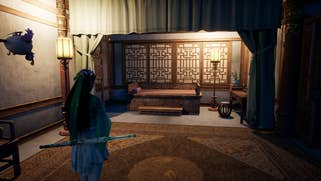
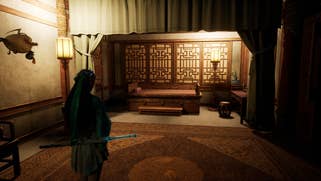
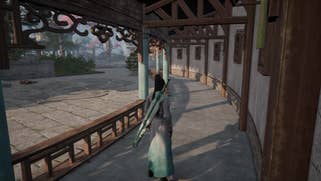
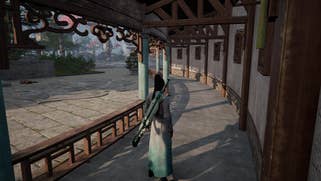
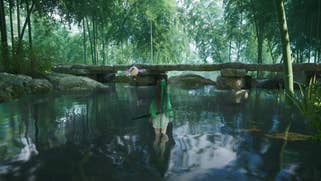
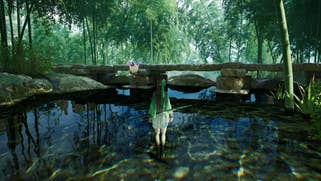
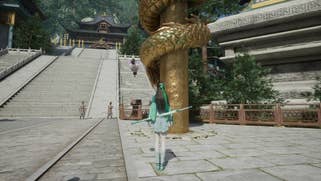

Ray tracing has a cost and that means compromising in performance when you use it, but optimised settings are possible. However, the game has a quirk in the menus that limits graphical options - turning on any of the RT features forces DLSS on and the RT options themselves are not flexible, meaning you can't turn on/off or tune individual RT features. Another issue that is that RT doesn't work at all right now on RDNA 2 GPUs from AMD. According to the developers, this will be fixed.
I'll leave it to the video to discuss the implications of performance, but suffice to say, the RTX 2060 - the least powerful Nvidia desktop GPU with RT support - is able to deliver 1080p30 gaming at the high setting, but really, you'll need to disable RT to game at 60fps instead. In terms of improving performance beyond RT, there are only two settings with much of an impact and the first is volumetric fog quality. Here, dropping down from high to medium for optimised settings is advised as it has a very faint difference in overall visual quality but a hefty performance win of 11 percent. The other optimised setting for mid to low-end GPUs is shadow quality, where dropping from high to low nets another eight percent in performance and only decreases shadow map resolution - but not to a degree that looks poor, with screen-space shadows helping to make up for what loss in quality there is. Other settings can be tweaked but I would not recommend it as that would compromise the game's visual identity too much - especially as pop-in for vegetation and other scene geometry is already borderline at the game's highest settings. Altogether, optimised settings saves around 15-17 percent in performance overall.
All together - using optimised settings can save up to 15 to 17% performance per scene while not looking too different on average. DLSS is also recommended with performance mode for 4K, balanced mode at 1440p and quality mode at 1080p. Right now, even with RT disabled, AMD GPUs seem to operate with a significant disadvantage to Nvidia counterparts - something that the developers and the Radeon driver team will hopefully look at.
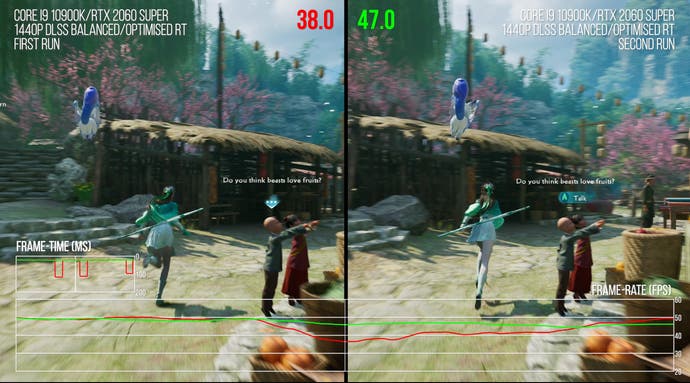
Beyond this, there are performance issues that seem to be related to Unreal Engine 4 that seem to crop up in virtually every UE4 title on PC that I test. One of these seems to be related to background streaming, which causes some frame-time instability but more pervasive are runtime shader compilation issues that cause severe stutter. Essentially the game compiles shaders on the fly as they are needed, meaning that for that first time, the title freezes - no matter how fast your PC is. This isn't so much of an issue on console as the fixed nature of the platform means that the game ships with all shaders re-compiled, but on PC, many games compile some or all of them as needed, producing this recurring problem. In the case of Sword and Fairy 7 there is actually a shader compilation step on first boot, but I must assume it's only compiling some of them as the problem manifests elsewhere in the game and feels really unpolished. I've seen it in so many UE4 titles now that I really do want to see Epic do something about it, as the onus seems to be on the developer to address the problem - and when it is fixed, it often happens post-release. Something needs to change here because too many games are shipping with the same issue.
Beyond these technical issues, I'm really happy to have discovered the Sword and Fairy series - and this seventh series entry really has much to commend it. The game's good, although perhaps there are a few too many cutscenes for my liking, while visuals are beautifully accomplished and make great use of Unreal Engine 4's cutting-edge feature set. I really do recommend giving it a go - despite the game's Far East origins, accessibility isn't a problem - as I mentioned, full English text is included and you don't need to look hard to find the game either, it's available on Steam right now.


